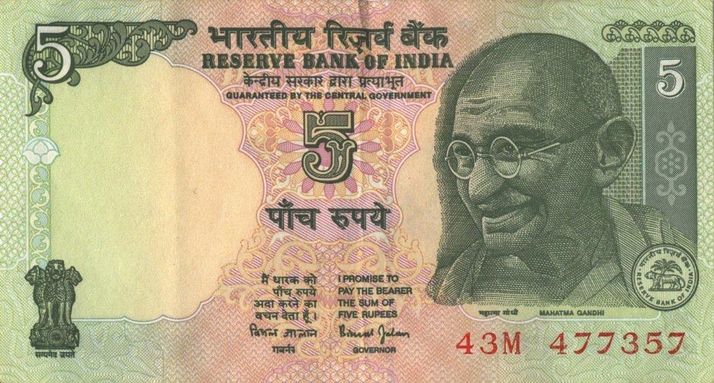top of page
اليوم السابع
September 6, 2021 at 12:00:00 AM

Please choose and click one of the following icons to discuss about this news in our Community.
تاريخ العملات في الهند من عصر المغول حتى ظهور غاندى "المبتسم" على الروبية (History of Coins in India from the Mughal Era to the Appearance of the "Smiling" Gandhi on the Rupee)
العملة الهندية الروبية لها ماض طويل إذ يكمن خلف وجه المهاتما غاندي المبتسم تاريخ طويل من النضال والاستكشاف والثروة التي يمكن إرجاعها إلى الهند القديمة في القرن السادس قبل الميلاد.
وهنا نتعرف على كيفية تطورت العملة الهندية على مر العصور إلى اليوم كما ذكرته صحيفة تايمز أوف إنديا الهندية.
كلمة "روبية"، حسبما ذكر موقع "تايمز اوف انديا" مشتقة من الكلمة السنسكريتية روبيكام ، وتعني عملة فضية، ويعود تاريخ الروبية الهندية إلى الهند القديمة في حوالي القرن السادس قبل الميلاد حيث كانت الهند القديمة واحدة من أوائل مصدري العملات المعدنية في العالم ، إلى جانب الوين الصيني
كانت هذه العملات مصنوعة من الفضة والوزن القياسي ولكن بأشكال غير منتظمة وعلامات مختلفة.
عززت إمبراطورية المغول من عام 1526 بعد الميلاد النظام النقدي للإمبراطورية بأكملها، في هذا العصر ، حدث تطور الروبية عندما هزم الامبراطور شير شاه خصمه سوري همايون وأصدر عملة فضية من 178 جرامًا تُعرف باسم الروبية وظلت هذه العملات المعدنية مستخدمة خلال فترة موجال وعصر مارثا والهند البريطانية.
وظلت الروبية الفضية تحظى بشعبية كبيرة. على الرغم من المحاولات العديدة لإدخال الجنيه الإسترليني في الهند ، نمت شعبية الروبية وتم تصديرها كعملة إلى المستعمرات البريطانية الأخرى.
في القرن الثامن عشر أصبح بنك هندوستان العام وبنك البنغال أول بنكين في الهند يصدران عملة ورقية، خلال هذا الوقت ، تم إصدار النقود الورقية لأول مرة في الهند.
غاندى
في القرن التاسع عشر، أدخل البريطانيون النقود الورقية في شبه القارة الهندية، و أعطى قانون العملة الورقية لعام 1861 للحكومة احتكار الأوراق النقدية الصادرة في جميع أنحاء الامتداد الشاسع للهند البريطانية ، والتي كانت مهمة كبيرة، في نهاية المطاف، عُهد بإدارة العملة الورقية إلى شركة Mint Masters والمحاسبين العامين ومراقبى العملة.
تم افتتاح بنك الاحتياطي الهندي رسميًا فى 1 أبريل 1935 ، مع مكتبه المركزي في كلكتا، وأصدر البنك أول ورقة من خمس روبية تحمل صورة جورج السادس في عام 1938، وتبع ذلك إصدار الروبية،فى 10 في فبراير، والـ 100 روبية في مارس و الـ1000 روبية والـ 10000 روبية في يونيو 1938، وتم توقيع أول إصدارات بنك الاحتياطي من قبل الحاكم الثاني ، السير جيمس تايلور.
وفى العصر الحديث وتحديدا عام 2016 تم تقديم الأوراق النقدية الجديدة التي تحمل صورة المهاتما غاندي، لتسليط الضوء على التراث الثقافي والإنجازات العلمية للبلاد، و تم استخدام ألوان مميزة لمختلف الطوائف وتم تقليل الأحجام، وهناك فئتان جديدتان حيث تم تقديم الـ2000 روبية في 8 نوفمبر 2016 والـ 200 روبية في 23 أغسطس 2017.
History of Coins in India from the Mughal Era to the Appearance of the "Smiling" Gandhi on the Rupee
The Indian Rupee has a long past. Behind the smiling face of Mahatma Gandhi lies a long history of struggle, exploration and wealth that can be traced back to ancient India in the 6th century BC.
Here, we learn how the Indian currency has evolved over the ages to today, as reported by the Times of India.
The word "rupee", according to the "Times of India" website, is derived from the Sanskrit word rubicam, which means silver coin. Chinese won side
These coins were made of silver, standard weight, but with irregular shapes and different signs.
The Mughal Empire from 1526 AD consolidated the monetary system of the entire empire. In this era, the development of the rupee occurred when Emperor Sher Shah defeated his opponent Suri Humayun and issued a silver coin of 178 grams known as the rupee. These coins remained in use during the Mughal period, the Maratha era and British India.
The silver rupee remained very popular. Despite many attempts to introduce the pound sterling in India, the rupee grew in popularity and it was exported as currency to other British colonies.
In the 18th century Hindustan Public Bank and Bank of Bengal became the first two banks in India to issue paper currency, during this time, paper money was first issued in India.
Gandhi
In the nineteenth century, the British introduced paper money in the Indian subcontinent, and the Paper Currency Act of 1861 gave the government a monopoly on banknotes issued throughout the vast expanse of British India, which was a major task, eventually, entrusting the management of paper currency to the Mint Masters, public accountants and currency controllers.
The Reserve Bank of India was officially inaugurated on 1 April 1935, with its central office in Calcutta, and the bank issued its first five-rupee note bearing the portrait of George VI in 1938, followed by the issuance of the rupee, on 10 February, the 100 rupees in March and the 1,000 rupees and the 10,000 rupees in June 1938, and the first issues of the Reserve Bank were signed by the second Governor, Sir James Taylor.
In the modern era, specifically in 2016, new banknotes bearing the image of Mahatma Gandhi were introduced, to highlight the cultural heritage and scientific achievements of the country. Distinctive colors were used for different denominations and sizes were reduced. There are two new denominations where the 2000 rupee was introduced on November 8, 2016 and the 200 rupees on August 23, 2017.
Source
© 2021 Mughal Library. All Rights Reserved.
bottom of page









